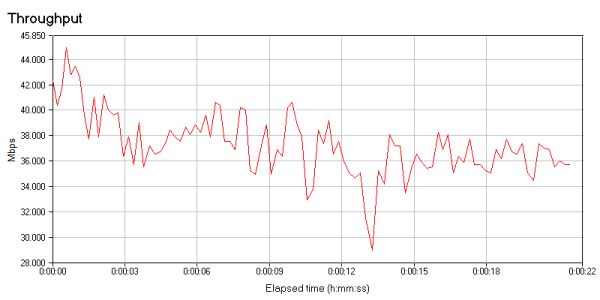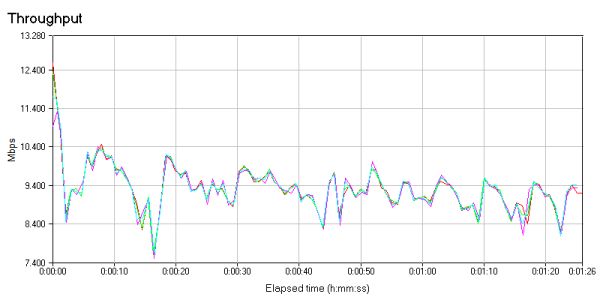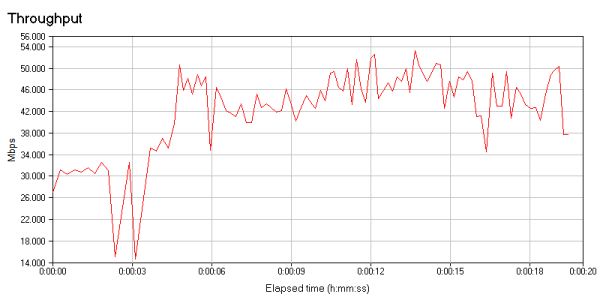Hands-On Powerline Networking: How Well (Or Not) Are Latest-Generation Devices Working?
by Brian Dipert on September 1, 2011 12:41 AM EST- Posted in
- Networking
- Powerline Adapters
- NetGear
The following table summarizes the abundant data I gathered across the 72 (and more...keep reading) tests, from one node combination to another, from one data-flow direction to another within a given node combination, and across the three adapter technologies that comprised this study:
| Average Bandwidth Testing Results (Mbps) | ||||||
| NETGEAR HomePlug AV1 | Sigma Designs HomePlug AV2 | NETGEAR IEEE 19013 | ||||
| Nodes | TCP (single-stream) | TCP (quad-stream) | TCP (single-stream) | TCP (quad-stream) | TCP (single-stream) | TCP (quad-stream) |
| 1->2 | 36.97 | 36.881 | 26.554 | 37.048 | 27.037 | 26.231 |
| 2->1 | 36.314 | 37.636 | 28.5 | 31.77 | 25.772 | 26.487 |
| 1->3 | 32.548 | 32.857 | 31.72 | 39.69 | 14.335 | 12.106 |
| 3->1 | 32.419 | 33.676 | 29.815 | 36.546 | 15.09 | 16.486 |
| 1->4 | 30.488 | 31.976 | 33.778 | 43.918 | 13.621 | 14.57 |
| 4->1 | 35.801 | 36.795 | 33.952 | 39.076 | 21.544 | 14.225 |
| 2->3 | 48.379 | 52.413 | 40.515 | 47.587 | 29.931 | 31.376 |
| 3->2 | 50.665 | 54.364 | 38.632 | 45.338 | 31.929 | 33.602 |
| 2->4 | 52.083 | 56.974 | 40.29 | 48.872 | 53.199 | 42.231 |
| 4->2 | 53.717 | 56.584 | 41.068 | 48.879 | 37.215 | 36.953 |
| 3->4 | 48.054 | 53.037 | 34.547 | 50.343 | 35.632 | 33.381 |
| 4->3 | 51.793 | 51.576 | 41.762 | 50.695 | 30.846 | 30.662 |
Nodes
- Dining room
- Living room
- Bedroom
- "Mud room"
Notes
- Firmware v0.2.0.5NA
- Firmware v1.2.15
- Firmware v0.2.0.9NA
Keep in mind that the table only shows only the average throughput across each test’s duration. Each single-number test summary omits per-stream average results for four-stream tests; the minimum and maximum per-stream and aggregate transfer rates across the test runtime; the overall transfer-rate pattern spread; and the measured minimum, maximum, average, and spread latency. The IxChariot reports embed all of this information and more. You can download a folder-delimited ZIP archive of all 72 report suites, in both native Ixia TST and exported TXT, PDF and HTML-plus-GIF formats, here.
In scanning over the data, you'll perhaps first notice that powerline network node 1 is the obvious bandwidth-compromised location. It's nearby the Dell XPS M1330, which acts as Media Center server for my Xbox 360s (acting as Media Center Extenders). Right now, I use a dedicated wide-channel 5 GHz 802.11n link to stream data from the laptop to my router. I'd originally thought that I could perhaps replace it with a powerline connection, thereby enabling me to (for example) simultaneously send multiple TV channels' worth of data to different game consoles. Guess not.
The Netgear XAV2001 (Qualcomm HomePlug AV) results closely align with those I've obtained in past studies using a number of different measurement schemes, giving me confidence both in this study's numbers and in my overall testing methodology. Note that the four-stream variant of each node-to-node TCP test delivered little to no incremental measured bandwidth versus the single-stream base case alternative.
That's not the case with the Sigma Designs-based HomePlug AV adapters. Although the single-stream results were respectable, they only exceeded those of the INT6400-based adapters in one of twelve cases. However, unlike with the INT6400-derived devices, the Motorola-branded HomePlug AV adapters showed consistent and significant speed improvements when I simultaneously sent four TCP streams through them, beating out the XAV2001s in five of twelve testing scenarios. Keep in mind, in comparing the Sigma Designs results with the others, that you're matching up a three-adapter Sigma Design topology against a five-adapter Netgear alternative...although in all three cases, only three adapters were in active use at any point in time (two Endpoint units, plus one at the router).
Finally, turn your attention to the AR7400-based Netgear XAV5001 IEEE 1901 adapters...and to the most baffling aspect of this study. In past testing, admittedly using different benchmark utilities and hardware configurations, the XAV5001s had exhibited consistent node combination-to-combination performance improvements over the XAV2001s, although the magnitude of the improvement varied depending on which specific node combination was being measured at the time. This time, on the other hand, the XAV5001s consistently undershot both adapter alternatives, and the XAV5001 four-stream testing setup even undershot the single-stream variant in a couple of cases.
I was so baffled by the outcome that I re-ran the XAV5001 tests several days later, obtaining a near-identical results set. I frankly don't know for sure what's going on, although I've seen similar discrepancies at other sites that have compared IEEE 1901 adapters to their HomePlug AV precursors. The last time I substantially tested the XAV5001 adapters, they were running the same firmware release as now, but it was springtime. Perhaps the overall power grid noise level is higher in late summer, or perhaps the higher ambient temperature caused a performance degradation; I've encountered similar scenarios in testing older-generation powerline technologies. Keep in mind, too, that the AR7400 is Qualcomm's first-generation IEEE 1901 chipset, versus the INT6400 third-generation HomePlug AV chipset, and that the associated AR7400 firmware is also comparatively immature.
One other Qualcomm-vs-Sigma Designs discrepancy bears mentioning. Check out these representative one- and four-stream testing bandwidth profiles from the Qualcomm AR7400 testing:
Now check out their Sigma Designs CG2110 counterparts:
Note that in the Qualcomm cases, bandwidth initially spiked high and then quickly tailed off to a steady-state value; the converse was the case with the Sigma Designs-based adapters.














53 Comments
View All Comments
EarthwormJim - Thursday, September 1, 2011 - link
You can typically follow other wiring in the house when retrofitting, like telephone wiring or coaxial wiring.Competition is probably high in my area, I often see several advertised specials from electricians specifically for cat 5 wiring.
bobbozzo - Thursday, September 1, 2011 - link
If you have (wall-to-wall) carpet, it's very easy to lift up the carpet a little and run cat5 under it... I ran a 100' drop in about 15mins.Also, you can get baseboard or crown molding which are gapped or routed (cut out) for wires to be hidden in.
e.g.
http://www.curbly.com/Chrisjob/posts/3618-Hide-you...
http://www.wiretracks.com/prod-cm.html
bobbozzo - Thursday, September 1, 2011 - link
Also, my alarm guy does cat5 drops through the attic for $30 each, which is a real bargain. He drops them behind curtains, etc., instead of through the walls to a wall box.bdipert - Thursday, September 1, 2011 - link
Dear bobbozzo, thanks for writing. You do realize, thought, that the feasibility and availability of such wiring options (far from their implementation) are way beyond the comprehension of the consumer masses...right? Versus going down to a nearby consumer electronics store, buying a couple of adapters, and plugging them into power outlets? If consumer electronics manufacturers targeted only the readers (and editors ;-) ) of AnandTech, they'd be able to get away with far less consumer-friendly offerings, because the bleeding-edge early adopters here would figure 'em out anyway. But the potential customer market would be a fraction of the size, as a result.bjacobson - Thursday, September 1, 2011 - link
can you review it, too?bdipert - Thursday, September 1, 2011 - link
Glad you all seem to dig my digs. I do, too ;-)bigpow - Thursday, September 1, 2011 - link
As someone who actually makes a living testing powerline comm, I find your article to be refreshing. Had to close my eyes and bite my tongue, going through the HW section, LOL, but everything after that is quite informative.fausto412 - Thursday, September 1, 2011 - link
i've been interested in this to run my home network and hookup my PC to the net over wireless..i also have 2 to 3 TIVO's i would love to network over faster speeds than wireless which would allow me to transfer shows real time between boxes.anybody able to speak to the capability of these setups in the real world?
froob - Friday, September 2, 2011 - link
Did you run any latency tests on these units? I'm interested to know how suitable Powerline networking would be for an Xbox 360 / PS3 etc.bdipert - Friday, September 2, 2011 - link
Dear froob,Yes, IxChariot logs a number of statistics, including latency, packet drop percentage, etc, I didn't explicitly create a table for latency, but you can find the data in the full report files I've archived here (as published in the 'TCP Testing Results' section of the article):
http://images.anandtech.com/doci/4695/PowerlineBen...